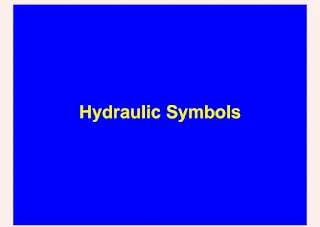Hydraulic symbols are standardized graphical representations used in schematics to illustrate the components, flow paths, and control functions within hydraulic systems. These symbols allow engineers, technicians, and operators to understand, design, and troubleshoot hydraulic circuits quickly and accurately. The symbols follow international standards, such as ISO 1219-1 and ISO 1219-2, ensuring consistency across industries and making it easier for individuals to read and interpret schematics regardless of the equipment or location.
Importance of Hydraulic Symbols
- Clarity and Efficiency: Symbols provide a clear and concise way to represent complex systems, reducing the need for lengthy descriptions.
- Standardization: Using standardized symbols ensures everyone interprets the schematics in the same way, minimizing errors and miscommunication.
- Troubleshooting and Maintenance: Hydraulic symbols allow technicians to quickly identify components and understand system operation, making it easier to diagnose and resolve issues.
- Design and Modification: Engineers can design, modify, and test hydraulic circuits on paper using these symbols before implementing them physically, saving time and resources.
Common Hydraulic Symbols
Hydraulic symbols fall into several categories based on the function of each component in the circuit. Here are some of the most common symbols:
Pumps:
- Fixed Displacement Pump: Represented by a circle with an arrow pointing outward, showing that the pump pushes fluid in one direction. Fixed displacement pumps have a constant flow rate.
- Variable Displacement Pump: Similar to the fixed pump symbol but with an additional arrow crossing the circle, indicating that flow rate can be adjusted.
Actuators:
- Cylinders (Linear Actuators): A simple rectangle represents a cylinder, with an arrow pointing in or out to indicate the direction of movement. Single-acting cylinders have one port, while double-acting cylinders have two ports.
- Hydraulic Motors (Rotary Actuators): Represented by a circle with an arrow curving around the outside, showing rotation. An adjustable hydraulic motor symbol may include a slanted arrow through it.
Valves:
- Directional Control Valve (DCV): Often represented by a series of squares, directional control valves direct fluid to different parts of a circuit. Arrows indicate flow paths, while squares show positions or states. For example, a two-position, three-way valve has two squares with arrows and ports indicating flow direction in two states.
- Pressure Control Valve: Shown with a spring and arrow, these valves regulate the system pressure. Pressure relief valves (which prevent over-pressurization) include an arrow pointing away from the spring.
- Flow Control Valve: Uses an arrow passing through a line, showing that it restricts flow. If adjustable, a diagonal arrow may be added.
Reservoirs and Lines:
- Reservoir: Represented by a rectangle or circle at the bottom of the diagram, indicating the storage of hydraulic fluid. An open rectangle with a line on top shows atmospheric venting.
- Lines: Different types of lines represent connections between components. Solid lines show working fluid paths, dashed lines represent pilot lines or control paths, and dotted lines often indicate drainage or leakage.
Filters:
- Basic Filter: Represented by a diamond shape in the middle of a line, indicating fluid filtration to remove contaminants.
- Pressure Filter: Shows a diamond in line with a pressure line, used in high-pressure filtering.
Accumulators:
- Represented by a circle with a dividing line, accumulators store energy in the form of pressurized fluid. Additional symbols may specify the type, such as a gas-loaded or spring-loaded accumulator.
Accessories:
- Pressure Gauge: Shown as a circle with a pointer or an arrow, pressure gauges monitor system pressure at various points.
- Check Valve: A small triangle pointing into a line, indicating one-way fluid flow, preventing backflow.
- Heat Exchanger: Represented by a coil or loop, showing the cooling or heating of hydraulic fluid.
Reading Hydraulic Symbols in Schematics
Hydraulic schematics use a combination of these symbols, showing how each component connects and interacts within a circuit. Here’s a simplified example of reading a hydraulic schematic:
- Flow Paths: The solid lines between symbols show the direction of fluid flow. Arrows within symbols or along lines indicate flow direction.
- Positioning and States: Directional control valves, for example, may show multiple states or configurations, such as open, closed, or diverted paths, helping visualize how the fluid can be rerouted.
- Connections: Intersection points between lines and symbols represent where components connect within the system, like a pump feeding fluid into a cylinder or passing through a pressure relief valve.
- Control Functions: Some components like valves include pilot or control lines that signal other components, showing how the system is controlled through pressure, force, or external inputs.
Key Benefits of Hydraulic Symbols for Technicians and Engineers
- Quick Diagnosis: Hydraulic symbols make it easier for technicians to pinpoint where issues might occur, such as leaks, pressure drops, or blockages.
- Streamlined Repairs: Standard symbols help technicians locate specific components quickly, improving response time and minimizing downtime.
- Enhanced Design Flexibility: Engineers can develop, test, and modify circuits using symbols, allowing for flexibility and accuracy in circuit design.
- Training and Documentation: Symbols serve as a universal language, making it easier to train new technicians and provide clear documentation for hydraulic systems.
Conclusion
Hydraulic symbols play a crucial role in the design, operation, and maintenance of hydraulic systems. By representing components and functions visually, they provide a clear and efficient way to communicate system design, diagnose problems, and train operators or technicians. Mastery of these symbols is essential for professionals in hydraulic engineering, allowing them to work efficiently and accurately across various applications and industries.

